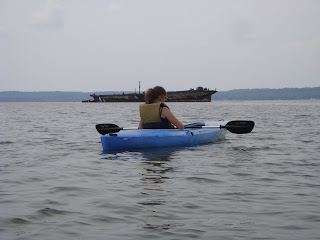Erin has one full day in Maryland between spending her summer as a Girl Scout counselor in Washington and the school year as a student in Massachusetts. I decided to take advantage of this one day by taking her kayaking with me at Mallows Bay. A week ago she was kayaking on the Hood Canal; today, she was kayaking on the Potomac River.
We put in the kayaks at the relatively new Mallows Bay Park that opened two years ago. In less than five minutes, we were alongside a rusty ship that marked the southern edge of a large wooden ship graveyard from World War I. Sources vary, but I’ve read that over 200 ships are in this bay. Many were between 250 and 300 feet long when they were built.
Off in the distance, we could see the Virginia shoreline, including the Quantico Marine Base. We saw marshland to our north and steep cliffs along the Maryland shore. The sky was overcast and a little threatening; the water was its usual murky green with about 12 inches of visibility. A few boats sped by providing us with the only wave action we encountered. The river is so wide at this point that even these waves were pretty small.
Most of the ships in the graveyard were just below the surface. As we neared them, I saw strange rows of something sticking up through the water. Upon closer review, I realized that they were steel bolts from the hulls of the ships. The local water fowl population uses them as perches.Then I realized that there were many of these rows throughout the bay. Each row signified another ship laid to rest. Occasionally, the kayak would bump into something just below the surface of the water that I hadn’t even seen.
As we paddled around, distant islands revealed themselves to be yet more ghost ships. These ships have become part of the local ecosystem. Over the years, they have started growing plants and even trees on them!The distant marshland I referred to above turned out to be the hulls that were closer to shore and, therefore, were seeded more easily by the shore birds. The environmental disaster of all these wooden ships sunk in one location has given rise to a profusion of protected artificial reefs where wildlife can flourish.
Kayaking among the ships was peaceful. The birds fished and flew, some cried at us while others watched quietly. A blue heron amazed me with its beauty and the osprey amazed me with the size of their nests.Something in the water would come up for air from time to time. I never saw the animal, but I heard it and saw the ripples.
As we returned to shore, a kayaker with fishing poles was just getting in. I asked him what he was fishing for, and he said he was looking for snakehead. So, while one ecological disaster has been averted, it seems another is threatening. Such is the way of life.
I haven’t been on the water for a number of years, but I love it. This trip has renewed my desire to explore many of the waterways in Southern Maryland. We are on a peninsula bounded by the Potomac River to the east, the Patuxent River to the west, and the Chesapeake Bay to the south. Just think of the possibilities. I am no longer able to portage canoes, but I am open to other explorations. If any of my water-loving friends want to go out with me, I’m all for it. Besides my neighbor who lent us these kayaks, I know of several kayak rental companies in the area. One puts in on MacIntosh Run just opposite of the Port of Leonardtown Winery. Anyone up for some paddling and wine tasting?
For those who prefer the virtual experience to the on-water experience, the following video on YouTube is a good rendition of what we saw: http://www.youtube.com/watch?v=E910Xh7xMDw







No comments:
Post a Comment